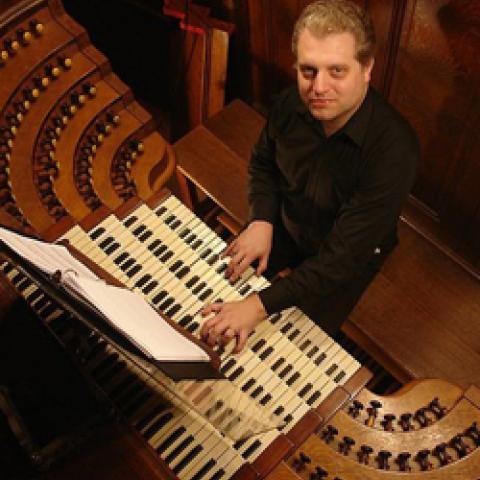ChicAGO Chapter AGO Celebrates Centennial
Mark your calendars now and reserve Monday June 11, 2007 as the ChicAGO Chapter AGO celebrates its "Centennial Anniversary"! International concert organist and recording artist Stephen Tharp will be featured in an organ recital at 7:00 PM at St. Vincent DePaul Roman Catholic Church, 1010 West Webster Street in Chicago. Following the organ recital, members, friends and guests of the ChicAGO Chapter AGO will enjoy a Buffet Dinner/Reception at 8:15 PM in the nearby Gothic Splendor of the Cortelyou Commons Building on the DePaul University Campus.
Stephen Tharp, hailed as "the organist for connoisseur" (Organ magazine, Germany). "the thinking person's performer" (Het Orgel), "every bit the equal of any organist" (The American Organist magazine) and "the consummate creative artist" (Michael Barone, Pipedreams), is recognized as one of the great concert organists of our time. Having played 28 solo intercontinental tours and more than 800 North American concerts, Stephen Tharp built one of the broadest and most well-respected international careers in the world, receiving critical acclaim around the globe. He is today regarded as the most traveled concert organist of his generation.
A native of Chicago, Tharp holds degrees from Illinois College in Jacksonville, Illinois and Northwestern University studying organ with Rudolf Zuiderveld and Wolfgang Rubsam respectively. He has also worked extensively with Jean Guillou in Paris. Tharp remains one of the most important champions of new organ music in the world and continues to commission and premier numerous compositions for the instrument. Tharp has commissioned organ works by Jean Guillou, David Briggs, Samuel Adler, Eugenio Fagiani, Thierry Escaich, Philip Moore, Anthony Newman, Martha Sullivan and Morgan Simmons.
Mr. Tharp's playing has been broadcast live on English and Irish national television, Radio Prague, Radio Netherlands and a Pipedreams broadcast dedicated exclusively to his concert career. Based for many years in New York City, Tharp has also been an active chamber musician having performed on organ, piano and harpsichord. His 12 solo organ recordings can be found on the JAV, Naxos, Organum and Ethereal labels. Stephen Tharp has held positions in Manhattan at both St. Patrick's Cathedral and St. Bartholomew's Church. In 2006 he was appointed Artist-in-Residence at historic St. Peter's Church, Perth Amboy, New Jersey, the oldest Episcopal parish in the state.
ChicAGO Chapter AGO Centennial Concert
Symphonie No. 1, Op. 13 Charles-Marie Widor
Marche Pontificale
Prelude & Fugue in C. Op. 13 Jeanne Demessieux
Carillon (1917) Leo Sowerby
Dryden Liturgical Suite, Op. 144 Vincent Persichetti
Prelude
Prayer
Toccata
Symphonie No. 5, Op. 47 Louis Vierne
Larghetto
Toccata Labyrinth (2006) David Briggs
(Commissioned by and Dedicated to Stephen Tharp)
St. Vincent DePaul Roman Catholic Church was founded in 1875, then located at the northernmost edge of Chicago. This church is a showcase design of James J. Egan and Charles H. Prindeville, architects who trained with the New York ecclesiastical specialist Richard Upjohn, best known for the 1846 Trinity Church, Wall Street in New York. The imposing broad Romanesque building of Bedford limestone was dedicated in May 1897. One of the chief glories of St. Vincent's interior is its sheer volume of uninterrupted space unlike most of the long basilica style plans of the churches of this period. St. Vincent's floor plan reads as almost square with corner shrines dividing the space into the shape of a Greek cross. Therefore, the altar can be viewed from every corner, a nod to the ideas of lay participation which would characterize 20th Century liturgical reform. Images from the life of Christ fill the windows of the sanctuary while grand scenes of Christ the King and St. Vincent DePaul fill the east and west transepts.
St. Vincent DePaul is home to the Chicago firm's Opus 80 of Lyon and Healy built and installed in 1901. After a fire in 1955 damaging the south end of the church, the 51 rank organ was rebuilt by the Tellers Organ Co. in 1959 retaining the original Lyon & Healy pipework. Several Pedal extensions and borrowings were added by Frank Sauter & Sons of Alsip, Illinois in 1994. Alfred J. Butler III of New York has carried out extensive repairs recently including the installation of a new Austin Organ, Inc. drawknob console.
The ChicAGO Chapter AGO cordially invites all of its members, friends and guests to attend this "Centennial Celebration" on June 11, 2007.
For your convenience, a "Centennial Celebration" reservation form for this Organ Recital and Buffet Dinner/Reception will be found included in this issue of the Console Crier. The Buffet Dinner/Reception cost is $30.00 per person and included admission to the Organ Recital. General Admission for the Organ Recital only is $10.00.
Everyone is encouraged to celebrate this occasion by subscribing as a Patron, Benefactor or Sustainer for the evening - these categories include multiple tickets for the Buffet Dinner and admission to the Organ Recital.
You are also encouraged to make a special Centennial Celebration Gift to the ChicAGO Chapter AGO.
All tickets will be held in reserve at St. Vincent DePaul Church.
Make reservations for the Centennial Celebration early since there is limited seating for the Buffet Dinner/Reception. SEE YOU ON JUNE 11, 2007!
CLICK HERE FOR INVITATION AND RESERVATION FORM
ChicAGO Chapter AGO Celebrates Centennial on June 11
ChicAGO Chapter AGO



